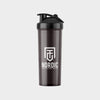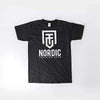Have you ever noticed the little dance movement and short pause people make when they're about to lift something heavy? The next time you're at the gym or watching a strongman competition, you'll notice the dangling straps around the person's wrist.
When they grab the barbell, they'll first adjust and bend the straps around the barbell and secure their grip. Suddenly, they lift the massive weight without any problem. So, what exactly do these straps do for you and why should you care about them?
Recommended product category:
What are lifting straps?
Lifting straps are fantastic tools for those who want to lift heavy at the gym or during strength training. They are made of strong and durable materials such as cotton, nylon, or leather and have a variety of uses. By using lifting straps, you can lift more weight and get better grip control, which allows you to perform exercises in a safer and more efficient way.
When you use lifting straps, such as our universal nylon or cotton lifting straps, you'll discover a variety of benefits. They provide extra support and protection for your forearms, reducing the risk of injury and overuse. They also help isolate the muscles you want to train and allow you to focus more on the exercise performance without worrying about dropping the barbell or dumbbell.
Our lifting straps are designed to fit all types of strength training, whether you're a beginner or an experienced athlete. They are suitable for many different exercises, such as deadlifts, barbell rows, lat pulldowns, shrugs, and much more. By using our lifting straps, you can take your training to the next level and achieve new heights of performance and strength.

Are there different types of lifting straps?
When choosing which type of lifting straps to use, it is important to understand the available options. There are different types of lifting straps on the market, such as
Lifting Straps,
Figure 8 Lifting Straps, and
Lifting Grips. Each type of lifting strap has its own function and benefits.
Lifting Straps are the most common type of lifting strap and are used to increase grip strength and reduce the load on the fingers and forearms during heavy lifts.
Figure 8 Lifting Straps are designed to provide a more secure grip by forming an 8-shape around the hand and barbell.
Lifting Grips are a combination of gloves and lifting straps that provide an extra layer of protection and support.
Choosing the right type of lifting strap can help improve your lifting technique and reduce the risk of injury. Consider the type of lift you are doing and the type of support you need before choosing which type of lifting strap suits you best.
How do lifting straps differ from wrist wraps?
When looking for the right pair of lifting straps, you may come across wrist wraps. Although they may look similar, they serve a completely different purpose.
Wrist wraps are designed to protect your wrists by reducing pressure and load on them, while lifting straps are designed to improve grip strength during heavy lifts. Lifting straps are thinner and made of materials such as cotton or nylon, while wrist wraps are thicker and wider and made of other materials.
So while lifting straps help you hold onto the barbell to increase your lifts, wrist wraps provide extra stability and support to the wrists to prevent injury and promote performance during pressing exercises.
Why should I use lifting straps?
Using lifting straps during strength training can be a fantastic tool to help you achieve your fitness goals and improve your results. One of the main benefits of lifting straps is that they can help you fatigue specific muscles without losing your grip. By reducing the load on your forearms and hands, you can focus more on the muscles you want to train, such as your back.
It is not uncommon to experience grip failure during heavy lifts, which can limit your training results and cause injuries. By using lifting straps, you can avoid this problem and continue to develop your muscles and strength.
So if you want to maximize your training results and train specific muscles without losing your grip, use lifting straps.
Which exercises can you use lifting straps for?
To have a strong and well-developed back, it's important to focus on exercises that train both the large back muscles and the trapezius muscles. Deadlifts are one of the most effective exercises for training the back and legs at the same time. However, for many people, grip strength can be a limiting factor in lifting heavy weights and pushing the body to its limits. By using lifting straps during deadlifts, you can remove this limiting factor and instead focus on lifting as heavy as you can, which will challenge your muscles in a more intense way.
Shrugs are another exercise that can benefit from using lifting straps. This exercise primarily trains the trapezius muscles and is performed by raising the shoulders to the ears while holding weights in your hands. By using lifting straps during shrugs, you can increase the load and maximize the effectiveness of the exercise without losing your grip.
Dumbbell or barbell rows are also an effective exercise for training the back muscles, especially the upper back. By using lifting straps during rowing exercises, you can increase the load on your muscles and focus on performing the exercise correctly, instead of worrying about losing your grip.
Romanian deadlifts are another exercise that can benefit from lifting straps. This exercise trains the hamstrings and gluteus muscles while also increasing the strength of the lower back. By using lifting straps during Romanian deadlifts, you can reduce the load on your forearms and grip strength, which will help you focus on lifting heavier weights and pushing yourself harder.
In summary, using lifting straps can be a valuable tool for increasing strength and muscle mass in the upper back, trapezius, and hamstrings. By using lifting straps, you can remove limiting factors such as grip strength and instead focus on pushing your muscles to their limits. However, it's important to use lifting straps correctly and only during heavy repetitions to avoid dependence and impaired grip strength over time.
How to prepare lifting straps
Preparing your lifting straps is not difficult. We have created a quick video below that shows you how to easily prepare your lifting straps. To summarize the video, we have created a list below. To put on and use your lifting straps, you want to:
- Slide one end of the long strap through the loop opening as if making a circle.
- Open your hands with your palms facing up and slide the loop over and onto your wrist.
- Make sure the end of each strap is facing in the direction of your thumb.
How to use lifting straps
Lifting straps are a useful training tool that can help you increase strength and muscle mass in certain exercises. However, to get the most out of your lifting straps, it is important to properly attach them around the barbell and use them correctly. Below is a step-by-step guide on how to attach lifting straps around a barbell and use them effectively:
- Place the lifting straps around your wrists: First and foremost, you need to place the lifting straps around your wrists. Make sure the straps are stretched and securely fastened around your wrists. Leave a portion of the strap hanging down from your wrists.
- Place one end of the strap on the barbell: Grab one end of the strap and place it over the barbell. Make sure the strap is placed properly on the barbell so that it doesn't slide in any direction when you start lifting.
- Wrap excess material around the barbell: Now it's time to wrap excess material around the barbell. Roll the strap around the barbell while twisting excess material on the strap around the bar in a twisting motion. Continue rolling until the excess material on the strap is utilized, and the lifting strap is snug around the barbell.
- Tighten the lifting strap: When you have wrapped excess material around the barbell, it's time to tighten the strap so that it is snug on the barbell. Grab the portion of the strap hanging down and roll it around your hand to create a tight grip. Tighten the strap by pulling up your hand and the barbell at the same time until the lifting strap is tight on the barbell and your wrists.
- Do the same with the other hand.
- Use the lifting straps correctly: Once you have properly attached the lifting straps, it's time to use them correctly. Lift the barbell as usual, but now you can let the lifting straps take some of the weight instead of just using the grip in your hands. The lifting straps will help you hold onto the bar effectively, allowing you to focus on training the muscles you want to focus on.
Things to remember when using lifting straps
When using lifting straps, it's important to remember a few things to get the most out of them:
Firstly, make sure you attach the lifting straps properly and wrap them tightly around the barbell to keep your wrist and hand tight against it. Wrapping the straps too loosely can actually cause damage to your hand/wrist and provide less support and grip.
Secondly, give it some time and use to notice the benefits of using lifting straps. You may notice less stress on your hands, wrists, forearms, and biceps when using them.
Thirdly, remember that lifting straps are not a replacement for training your grip strength. Use them as a tool to help you lift heavier weights and build muscle, but also continue to work on your grip strength by performing exercises that strengthen your hands and wrists.
Summary of lifting straps
Using lifting straps can have many benefits for you during your workout. They are designed to help you with heavy lifts and provide better grip control during exercises such as deadlifts, barbell rows, lat pulldowns, and shrugs. By using lifting straps, you can reduce stress on your hands, forearms, and biceps, allowing you to focus more on the muscles you want to train.
But it's important to use lifting straps in moderation and not rely on them for all your heavy lifts. They are a tool to help you, but you should still focus on building your grip strength and training without lifting straps as well.
We at Nordic Training Gear manufacture high-quality lifting straps in both cotton with neoprene padding to avoid discomfort and in nylon for a closer grip. Our lifting straps are designed for use in powerlifting, strongman, bodybuilding, crossfit, and weightlifting, and we offer a wide range to suit all your training needs.
You can find all our quality lifting straps here.
 Lifting Straps
Lifting Straps Lifting Belts
Lifting Belts Nordic Grips
Nordic Grips Knee Sleeves
Knee Sleeves Elbow Sleeves
Elbow Sleeves Wrist Wraps
Wrist Wraps Knee Wraps
Knee Wraps Smelling Salt
Smelling Salt Supplements
Supplements  Neoprene Shorts
Neoprene Shorts Grip Shirt
Grip Shirt Deadlift socks
Deadlift socks Gym Chalk
Gym Chalk  Lifting Shoes
Lifting Shoes Strongman Tacky
Strongman Tacky Stone Sleeves
Stone Sleeves Sandbags
Sandbags Calf & Shin Sleeves
Calf & Shin Sleeves Compression Cuffs
Compression Cuffs Accessories
Accessories
 Best Seller
Best Seller Sale
Sale News
News Lifting Straps
Lifting Straps Lifting Belts
Lifting Belts Nordic Grips
Nordic Grips Knee Sleeves
Knee Sleeves Elbow Sleeves
Elbow Sleeves Wrist Wraps
Wrist Wraps Knee Wraps
Knee Wraps Smelling Salt
Smelling Salt Supplements
Supplements  Neoprene Shorts
Neoprene Shorts Grip Shirt
Grip Shirt Deadlift socks
Deadlift socks Gym Chalk
Gym Chalk  Lifting Shoes
Lifting Shoes Strongman Tacky
Strongman Tacky Stone Sleeves
Stone Sleeves Sandbags
Sandbags Calf & Shin Sleeves
Calf & Shin Sleeves Compression Cuffs
Compression Cuffs Accessories
Accessories



 Lifting Straps
Lifting Straps Lifting Belts
Lifting Belts Nordic Grips
Nordic Grips Knee Sleeves
Knee Sleeves Elbow Sleeves
Elbow Sleeves Wrist Wraps
Wrist Wraps Knee Wraps
Knee Wraps Smelling Salt
Smelling Salt Neoprene Shorts
Neoprene Shorts Grip Shirt
Grip Shirt Deadlift socks
Deadlift socks Lifting Shoes
Lifting Shoes Strongman Tacky
Strongman Tacky Stone Sleeves
Stone Sleeves Sandbags
Sandbags Calf & Shin Sleeves
Calf & Shin Sleeves Compression Cuffs
Compression Cuffs Accessories
Accessories








